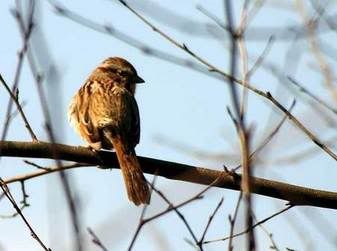May the bluebird of happiness......

This is that time of year in the lives of birders that things become a bit frenetic. One can hardly keep up with the postings of new sightings on the various state lists, and jobs become an unwelcome annoyance when so much is happening out there. Luckily, my spring break as a teacher coincided with some perfectly lovely weather, so I was able to spend long, long stretches of time out in some of my favorite birding spots to see what I could see. It was sublime, but other than my Carolina Wren, nothing new was discovered. I spent some time after work earlier this week at a Mississippi River birding spot looking for migrating passerines. This is a great spot, one where I've spent hours since last fall, but which will quickly become a miserable location from the human standpoint. Lots of standing water equals lots of biting insects. That didn't seem to bother the many Yellow Rumped Warblers I enjoyed; in fact, they were thrilled. Following the rule that no camera means excellent views, these little charmers perched at eye level close to me, snatching bugs from the other side of upright branches, then darting back to their perch. Their contact calls were for the most part soft; with so many of them in close proximity, the louder harsher calls were hardly needed. Toward evening, a few began singing, so perhaps they are establishing territory right here.
White-Throated Sparrows and an Eastern Towhee also gave very close looks, though that Towhee would have been impossible to photograph, anyway. Lurking under brushy tangles, I'd catch nice looks for but a moment before he ducked into denser cover near the ground.
I made an attempt to see some new birds reported the other day, Bonapartes Gulls and Horned Grebes. I might even have seen them. Something white was bobbing up and down in the location reported. I need that scope!
Though I didn't add to the all-important list as a result of my lack in birding gear, it's really not important at all. What matters is that I go out into the woods, the shorelines, the wetlands, and spend time in the company of our wild feathered friends and other wild things. I stop and listen, look and see, enjoy learning more about each as it presents itself. There are more warblers on their way, many of which I've never seen, or at least didn't know I was seeing. Where some would call a day at the mall a perfect day, I call any time out in nature, removed from the noise and trappings of "civilization," a day well spent. Whether I add those new birds or not, time outdoors will reward me with time to contemplate my world, and unexpected moments of connection...perhaps even giving me, for just a moment, the Bluebird of Happiness!











